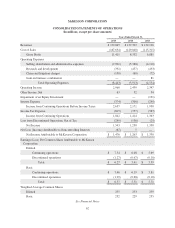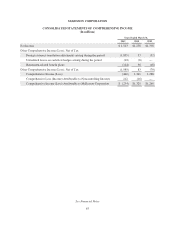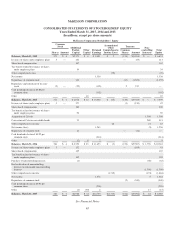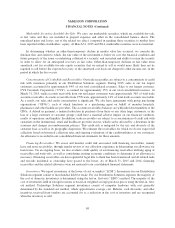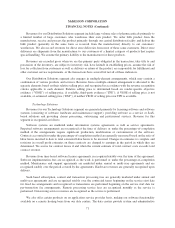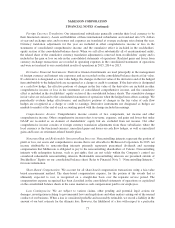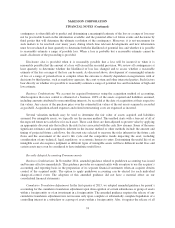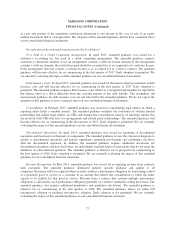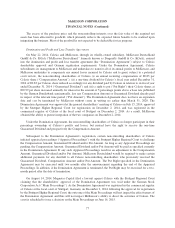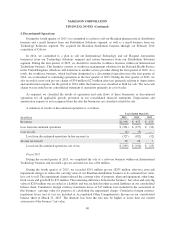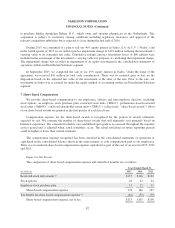McKesson 2015 Annual Report Download - page 77
Download and view the complete annual report
Please find page 77 of the 2015 McKesson annual report below. You can navigate through the pages in the report by either clicking on the pages listed below, or by using the keyword search tool below to find specific information within the annual report.McKESSON CORPORATION
FINANCIAL NOTES (Continued)
support, as well as hosting services. Revenue on products sold on an application service provider basis is
recognized on a monthly basis over the term of the contract beginning on the service start date of products
hosted.
This segment engages in multiple-element arrangements, which may contain any combination of software,
hardware, implementation, SaaS-based offerings, consulting services or maintenance services. For multiple-
element arrangements that do not include software, revenue is allocated to the separate elements based on their
relative selling price and recognized in accordance with the revenue recognition criteria applicable to each
element. Relative selling price is determined based on VSOE of selling price if available, TPE, if VSOE of
selling price is not available, or ESP if neither VSOE of selling price nor TPE is available. For multiple-element
arrangements accounted for in accordance with specific software accounting guidance when some elements are
delivered prior to others in an arrangement and VSOE of fair value exists for the undelivered elements, revenue
for the delivered elements is recognized upon delivery of such items. The segment establishes VSOE for
hardware and implementation and consulting services based on the price charged when sold separately, and for
maintenance services, based on renewal rates offered to customers. Revenue for the software element is
recognized under the residual method only when fair value has been established for all of the undelivered
elements in an arrangement. If fair value cannot be established for any undelivered element, all of the
arrangement’s revenue is deferred until the delivery of the last element or until the fair value of the undelivered
element is determinable. For multiple-element arrangements with both software elements and nonsoftware
elements, arrangement consideration is allocated between the software elements as a whole and nonsoftware
elements. The segment then further allocates consideration to the individual elements within the software group,
and revenue is recognized for all elements under the applicable accounting guidance and our policies described
above.
Supplier Incentives: Fees for service and other incentives received from suppliers, relating to the purchase or
distribution of inventory, are generally reported as a reduction to cost of goods sold. We consider these fees and
other incentives to represent product discounts and as a result, the amounts are recorded as a reduction of product
cost and are recognized through cost of goods sold upon the sale of the related inventory.
Supplier Reserves: We establish reserves against amounts due from suppliers relating to various price and
rebate incentives, including deductions or billings taken against payments otherwise due to them. These reserve
estimates are established based on judgment after considering the status of current outstanding claims, historical
experience with the suppliers, the specific incentive programs and any other pertinent information available. We
evaluate the amounts due from suppliers on a continual basis and adjust the reserve estimates when appropriate
based on changes in factual circumstances. As of March 31, 2015 and 2014 supplier reserves were $167 million
and $181 million. The ultimate outcome of any outstanding claims may be different than our estimate. All of the
supplier reserves at March 31, 2015 and 2014 pertain to our Distribution Solutions segment.
Income Taxes: We account for income taxes under the asset and liability method, which requires the
recognition of deferred tax assets and liabilities for the expected future tax consequences of events that have been
included in the financial statements. Under this method, deferred tax assets and liabilities are determined based
on the difference between the financial statements and the tax basis of assets and liabilities using enacted tax
rates in effect for the year in which the differences are expected to reverse. Tax benefits from uncertain tax
positions are recognized when it is more likely than not that the position will be sustained upon examination,
including resolutions of any related appeals or litigation processes, based on the technical merits. The amount
recognized is measured as the largest amount of tax benefit that is greater than 50 percent likely of being realized
upon effective settlements. Deferred taxes are not provided on undistributed earnings of our foreign operations
that are considered to be permanently reinvested.
72


